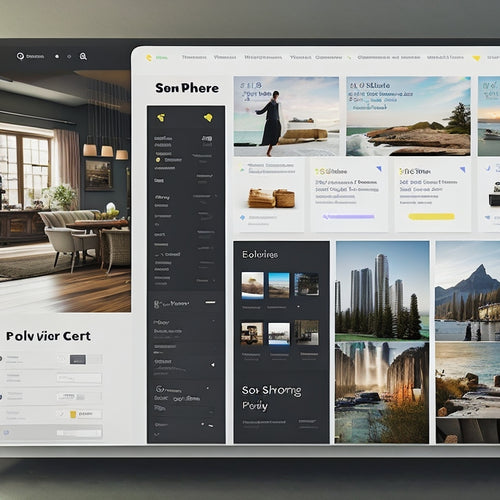
Diagnose and Fix Technical Issues in Online Stores
Share
You're likely losing sales and compromising customer trust due to undiagnosed technical issues lurking in your online store, waiting to be fixed. Identify root causes of downtime, like server overload or coding inefficiencies, and prioritize security measures to protect customer data. Slow page loads, payment gateway errors, and mobile optimization problems can also erode trust and hurt conversions. To diagnose and fix these issues, inspect payment gateway logs, review server response times, and optimize images. By addressing these bottlenecks, you'll enhance customer experience and boost sales. Now, take a closer look at the specific issues plaguing your online store.
Key Takeaways
• Identify and address server downtime, SSL certificate issues, and payment gateway errors to prevent lost sales and customer frustration.
• Optimize website performance by resolving bottlenecks, such as server overload, coding inefficiencies, and network latency problems.
• Ensure mobile optimization by improving loading times, responsive design, and accessible CTAs to increase conversion rates.
• Troubleshoot payment gateway errors by reviewing integration, security vulnerabilities, and logs to pinpoint and resolve transaction processing issues.
• Improve page load times by optimizing images and server response times to enhance user experience and boost sales.
Common Ecommerce Technical Issues
What technical issues are you most likely to encounter in your online store, and how do they impact your customers' shopping experience?
As an ecommerce entrepreneur, you're bound to face server downtime, which can lead to lost sales, damaged reputation, and frustrated customers. To mitigate this, you need to have effective troubleshooting techniques in place, such as identifying the root cause, checking server logs, and performing routine maintenance.
Another critical issue is ensuring the security of your customers' data. A compromised SSL certificate can lead to a loss of trust and ultimately, a decline in sales. To prevent this, you need to implement robust security measures, such as regular certificate renewals, encryption, and secure payment gateways. By prioritizing these security measures, you can protect your customers' sensitive information and maintain a trustworthy online store.
Website Performance Bottlenecks
When your online store's website performance slows down, it can lead to frustrated customers, abandoned carts, and ultimately, lost sales, making it crucial to identify and address the underlying bottlenecks. You need to pinpoint the root causes of the slowdown to prevent further revenue loss.
One common culprit is server overload issues, which can be caused by a surge in traffic, inadequate server resources, or inefficient coding practices. You should review your server's capacity and optimize your code to reduce the load. Coding inefficiencies can also slow down your website, so it's vital to refactor your code to improve performance.
Network latency problems can also hinder your website's speed, often due to issues with your content delivery network (CDN) or DNS resolution. Ensure your CDN is properly configured and consider using a faster DNS service.
Database connection errors can also slow down your website, so verify that your database is properly indexed and optimized for queries. By identifying and addressing these bottlenecks, you can notably improve your website's performance, leading to a better customer experience and increased sales.
Mobile Optimization Problems
As online shopping increasingly shifts to mobile devices, ensuring that your website is optimized for mobile is essential, since a slow or unresponsive mobile experience can lead to frustrated customers and lost sales. You can't afford to neglect mobile optimization, as it's a vital aspect of your online store's success.
Here are some common mobile optimization problems that can hinder your website's performance:
-
Slow loading times: Your website takes too long to load, causing users to abandon their shopping carts.
-
Unresponsive design: Your website's layout isn't adaptable to different screen sizes, making it difficult for users to navigate.
-
Poorly optimized images: Large image files slow down your website's loading time, negatively impacting user experience.
- Inaccessible CTAs: Your calls-to-action (CTAs) aren't easily clickable on mobile devices, reducing conversion rates.
Payment Gateway Errors
Failing to properly integrate and configure your payment gateway can lead to a slew of errors that disrupt transactions and erode customer trust. When you encounter transaction processing errors, it's vital to employ effective troubleshooting strategies to identify and resolve the issue promptly.
Start by reviewing your payment gateway integration, confirming that all necessary APIs and credentials are correctly set up. Check for security vulnerabilities that may be compromising your payment processing. Verify that your SSL certificates are up-to-date and functioning correctly.
Next, inspect your payment gateway's logs to pinpoint the error source. Are there any recurring patterns or anomalies that can help you identify the root cause? Analyze your code and database queries to make sure they're correctly handling payment processing requests.
If you're still stuck, reach out to your payment gateway's support team for assistance. By following these steps, you'll be well-equipped to diagnose and fix payment gateway errors, ensuring seamless transaction processing and maintaining customer confidence in your online store.
Slow Page Load Times
About 47% of online shoppers expect a webpage to load in 2 seconds or less, and slow page load times can lead to frustrated customers and lost sales. You can't afford to lose potential customers due to slow loading times.
Here are some alarming facts about slow page load times:
- Every 1-second delay in page load time results in a 7% reduction in conversions.
- 40% of customers will abandon a website that takes more than 3 seconds to load.
- The average user expects a website to load in under 3 seconds, but the average load time is around 8 seconds.
- Slow page load times can also negatively impact your search engine rankings.
To address slow page load times, you'll need to identify the root causes. Two common culprits are poor image optimization and slow server response times. By optimizing your images and improving your server response times, you can considerably reduce your page load times and improve the overall user experience.
Browser Compatibility Issues
You've optimized your images and improved server response times, but now it's time to verify that your online store is compatible with various browsers, since customers can access your site from different devices and browsers, and a single compatibility issue can lead to a poor user experience.
To ensure a seamless user experience, you need to conduct cross browser testing to identify and fix CSS rendering issues. Here's a snapshot of what you might encounter:
| Browser | Version | CSS Rendering Challenges |
|---|---|---|
| Chrome | 89.0 | Layout challenges with flexbox |
| Firefox | 78.0 | Challenges with CSS grid |
| Safari | 14.1 | Issues with CSS animations |
| Edge | 88.0 | Inconsistent font rendering |
| Internet Explorer | 11.0 | Compatibility challenges with CSS3 |
Broken Link and Image Errors
When examining your online store's performance, it's important to identify and rectify broken link and image errors, as they can significantly hamper user experience and search engine optimization. These errors can result in unhappy customers, lost sales, and reduced search engine rankings.
To avoid these outcomes, you should:
-
Unhappy customers: Broken links and images can lead to a subpar user experience, causing customers to abandon their shopping carts and never return.
-
Missed sales opportunities: A single broken link can hinder a customer from completing a purchase, leading to lost revenue and missed chances.
-
Lowered search engine rankings: Search engines like Google can penalize your site for broken links and images, adversely affecting your SEO optimization strategies.
- Adverse brand reputation: Frequently encountering broken links and images can harm your brand's reputation, making it more challenging to attract and retain customers.
To address these errors, make sure your online store has a responsive design, and utilize image compression techniques to decrease file sizes. By doing so, you'll enhance user experience, improve SEO, and increase sales.
Frequently Asked Questions
How Do I Handle Sudden Spikes in Online Store Traffic?
When handling sudden traffic spikes, you'll want to implement scalability measures, like load balancing and cloud hosting, while closely monitoring server performance to guarantee seamless user experiences and prevent crashes.
What Tools Are Best for Tracking Ecommerce Technical Issues?
You'll need robust ecommerce monitoring tools to identify technical issues, such as New Relic or Datadog, which provide real-time insights to inform your troubleshooting strategies and guarantee swift resolutions to maintain a seamless customer experience.
Can I Outsource Technical Issue Diagnosis and Fixing?
As you navigate the labyrinth of ecommerce technical woes, you're tempted to outsource diagnosis and fixing; consider the benefits of outsourcing, weigh costs, and ponder remote vs in-house solutions to optimize your online empire's efficiency.
How Often Should I Perform Technical Issue Audits?
You should perform technical issue audits frequently, ideally quarterly, to prevent minor issues from escalating into major problems, as neglecting audits can lead to revenue loss, reputational damage, and security breaches.
Are There Any Technical Issue Diagnosis Tools for Beginners?
"Ha! You think you're not tech-savvy? Think again! You'll be a pro in no time with troubleshooting tools like Chrome DevTools, GTmetrix, and Screaming Frog, which help you identify common errors and provide actionable tips for beginners."
Related Posts
-
The Benefits of Shoppable Videos
Shoppable videos have emerged as a powerful tool for businesses to enhance customer engagement, increase conversion ...
-

What Are the Benefits of Creating a Sitemap
The benefits of creating a sitemap have been widely recognized in the field of search engine optimization (SEO). Sit...
-

Unleashing Shopify's Surprising Power in Ecommerce
Shopify has emerged as a powerful force in the ecommerce industry, offering numerous advantages for brands seeking t...

